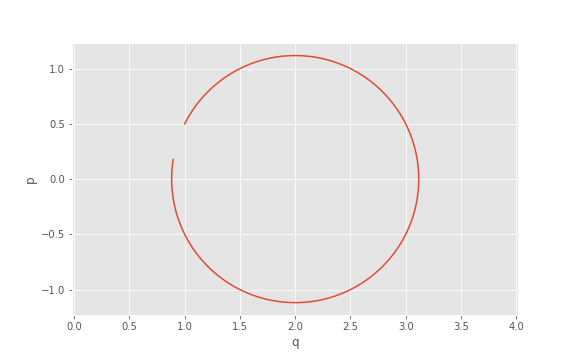Forced quantum harmonic oscillator¶
Section author: Josh Izaac <josh@xanadu.ai>
Simulating the time-propagation of a Gaussian Hamiltonian using a continuous-variable (CV) quantum circuit is simple with SFOpenBoson. In this tutorial, we will walk through a simple example using the forced quantum harmonic oscillator.
Background¶
The Hamiltonian of the forced quantum harmonic oscillator is given by
where
- \(m\) is the mass of the oscillator,
- \(\omega\) is the frequency of oscillation,
- \(F\) is a time-independent external force.
Let’s define this Hamiltonian using OpenFermion, with \(m=\omega=1\) and \(F=2\):
>>> from openfermion.ops import QuadOperator
>>> from openfermion.utils import commutator, normal_ordered
>>> H = QuadOperator('q0 q0', 0.5) + QuadOperator('p0 p0', 0.5) - QuadOperator('q0', 2)
In the Heisenberg picture, the time-evolution of the \(\q\) and \(\p\) operators is given by:
We can double check these using OpenFermion:
>>> (1j/2)*normal_ordered(commutator(H, QuadOperator('q0')), hbar=2)
1 [p0]
>>> (1j/2)*normal_ordered(commutator(H, QuadOperator('p0')), hbar=2)
2 [] + -1 [q0]
Assuming the oscillator has initial conditions \(\q(0)\) and \(\p(0)\), it is easy to solve this coupled set of linear differential analytically, giving the parametrised solution
Let’s now attempt to simulate these dynamics directly in Strawberry Fields, solely from the Hamiltonian we defined above.
Strawberry Fields simulation¶
To simulate the time-propagation of the forced oscillator in StrawberryFields, we also need to import the GaussianPropagation class from the SFOpenBoson plugin:
>>> import strawberryfields as sf
>>> from strawberryfields.ops import *
>>> from sfopenboson.ops import GaussianPropagation
GaussianPropagation accepts the following arguments:
operator: a bosonic Gaussian Hamiltonian, either in the form of aBosonOperatororQuadOperator.t(float): the time propagation value. If not provided, default value is 1.mode(str): By default,mode='local'and the Hamiltonian is assumed to apply to only the applied qumodes. For example, ifQuadOperator('q0 p1') | (q[2], q[4]), thenq0acts onq[2], andp1acts onq[4].
Alternatively, you can set mode='global', and the Hamiltonian is instead applied to the entire register by directly matching qumode numbers of the defined Hamiltonian; i.e., q0 is applied to q[0], p1 is applied to q[1], etc.
Let’s set up the one qumode quantum circuit, propagating the forced oscillator Hamiltonian H we defined in the previous section, starting from the initial location \((1,0.5)\) in phase space, for time \(t=1.43\):
>>> prog = sf.Program(1)
>>> with prog.context as q:
... Xgate(1) | q[0]
... Zgate(0.5) | q[0]
... GaussianPropagation(H, 1.43) | q
Now, we can run this simulation using the Gaussian backend of Strawberry Fields, and output the location of the oscillator in phase space at time \(t=1.43\):
>>> eng = sf.Engine("gaussian")
>>> state = eng.run(prog).state
>>> state.means()
array([ 2.35472067, 1.06027036])
We compare this to the analytic solution,
which is in good agreement with the Strawberry Fields result.
We can also print the CV gates applied by the engine, to see how our time-evolution operator \(e^{-i\hat{H}t/\hbar}\) got decomposed:
>>> eng.print_applied()
Xgate(1), (reg[0])
Zgate(0.5), (reg[0])
Rgate(-1.43), (reg[0])
Xgate(1.719), (reg[0])
Zgate(1.98), (reg[0])
Plotting the phase-space time evolution¶
By looping over various values of \(t\), we can plot the phase space location of the oscillator for various values of \(t\).
Consider the following example:
eng = sf.Engine("gaussian")
t_vals = np.arange(0, 6, 0.02)
results = np.zeros([2, len(t_vals)])
for step, t in enumerate(t_vals):
prog = sf.Program(1)
with prog.context as q:
Xgate(1) | q[0]
Zgate(0.5) | q[0]
GaussianPropagation(H, t) | q
state = eng.run(prog).state
eng.reset()
results[:, step] = state.means()
Here, we are looping over the same circuit as above for values of \(t\) within the domain \(0\leq t<6\), and storing the resulting expectation values \((\braket{\q(t)}, \braket{\p(t)})\) in the array results. We can plot this array in phase space:
>>> from matplotlib import pyplot as plt
>>> plt.plot(*results)


